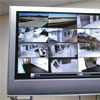
Ensuring Patient Privacy, Enhancing Security
New, smarter surveillance technologies are perfect prescription for healthcare settings
- By Greg Peratt
- Jun 01, 2012
Today’s video surveillance camera manufacturers offer models specifically
built for the healthcare setting. Vandal-proof cameras withstand
rough treatment in an emergency room, high-resolution models
can read license plate numbers in the parking lot and better image
processing enables clear video views in spite of backlighting or other
lighting variables.
Video surveillance systems are proving to more useful than ever in healthcare
facilities thanks to new capabilities made possible through enhanced processing,
intelligent video analytics and continually evolving network functionality. In addition
to providing better security for patients, staff and visitors, video surveillance
systems can also improve general operations throughout healthcare facilities even
while protecting patients’ privacy.
Intelligent Camera Functions
Video motion detection built into intelligent cameras can alert hospital personnel
if patients are mobile in areas where they should be stationary, and it can be
used to generate an alarm if identified fixed objects are moved while at the same
time ignoring other motion caused by natural elements such as swaying trees or
drifting clouds.
In addition, video motion detection can monitor portable equipment and vehicles
that should not be left unattended or those that remain stationary for specified
time limits, and the built-in technology can trigger alarms when an object is
left behind, such as a briefcase or other package that might represent a security
threat. All of these motion detection-related capabilities can be deployed to record
activities only when motion is triggered. This dramatically reduces bandwidth requirements,
allowing more devices to be deployed on a single network without
impeding transmission while also requiring less storage for recorded images.
Face detection is another feature driven by intelligent analytics on the camera,
and it pairs with face recognition on the recording/processing end of the system
chain.
In addition to automatically detecting individuals registered in the system or
suspicious persons when they enter a facility, face detection can provide instant
access to secured areas by authorized personnel. Applications include maternity
wards, areas where medications are stored, operating rooms and emergency treatment
areas. Face detection can be used as a standalone trigger mechanism or in
conjunction with access control, making it suitable for myriad applications.
Protecting Patient Privacy
Emerging surveillance technology is enabling better patient protection in healthcare
settings while maintaining the need for privacy. Cameras can be placed in
a specially designed housing that covers the lens at all times unless opened by a
patient or nurse to monitor a specific incident or situation. A single PTZ camera
can be deployed in rooms with multiple patients and programmed to position itself
toward any of the beds.
If a patient or family member temporarily leaves the room, they can request a
video recording to protect valuables and other personal items.
New, smarter network cameras also offer a privacy-masking capability. Various
areas in an image, such as the door to a patient’s room or a patient’s window
viewed from the outside, can be electronically masked to prevent the selected areas
from being viewed and/or recorded. This allows video surveillance cameras to be
deployed virtually anywhere throughout and around a healthcare facility without
infringing on patient privacy.
Surveillance for Business and Education
Video cameras are used throughout hospitals and healthcare facilities for a multitude
of non-security tasks, including remote conferencing and in operating rooms
for educational purposes. These cameras can also be called upon for use as security
cameras on a moment’s notice in the event of an emergency.
Overall, the capabilities of video cameras to improve, secure
and streamline today’s healthcare environment are better than
ever.
This article originally appeared in the June 2012 issue of Security Today.
About the Author
Greg Peratt is director of sales, Video Solutions Integration, at Panasonic.